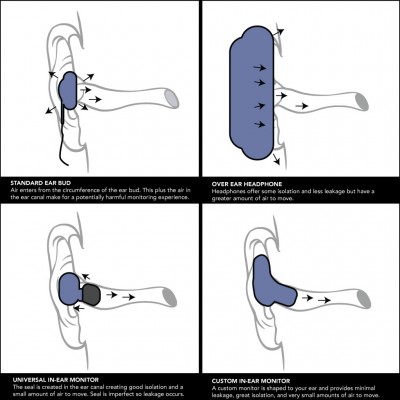As our churches move towards personal monitoring and wireless monitoring solutions, we are getting more familiar with the concept of using in-ear monitors. In-ear monitors are either custom or universal fit “headphones” that are placed directly into the ear canal vs. sitting in the ear like an ear bud might or over the ear like larger headphones.
It might seem counter-intuitive, but in-ear monitors (IEMS) are actually safer for your ears when used properly than earbuds or over the ear headphones. The reason for this comes down to air, or the lack thereof. How is this possible?
NOISE REDUCTION
Your IEM reduces the ambient noise coming to your ear so that what you do hear is from your monitors, not the stage. If your stage is really loud, then your monitors need to be at “really loud plus one” to hear them. Cutting that noise reduces how loud you need to have your monitors.
REDUCED LEAKAGE
Having a good seal means more of the monitors sound waves reach your ear. Low frequencies especially like to get out wherever they can. A good seal gives you a balanced mix in both ears without rogue sound waves breaking free.
LESS AIR TO MOVE
Imagine a toy boat on the ocean. A small wave will move the boat. A large wave will move the boat but may also capsize it. Sound pressure works the same. Your ear drum is small and very sensitive, it doesn’t take much to move it. A good seal on your monitors means you can move the eardrum with small waves and less pressure. The more air you have to move, the more pressure you need to move it and the more dangerous it can be.
So what is the biggest risk to your ear safety when using in-ear monitors? Breaking the seal.
If you are using a universal fit monitor like the Alclair Curve, UE 900, or Shure SE425s, make sure you select a tip that creates a good seal. Silicon may be more comfortable, but often foam tips such as those made by Comply will make a better seal. Tips come in various sizes so make sure to select one that maximizes that seal.
If you are using a custom in-ear monitor, make sure you have a good seal on both ears. And remember to check every few months or so. Our ears continue to grow as long as we live so it is to be expected that your ear will outgrow your custom IEM seal. When you get accustomed to it you might not realize that the seal has changed. Consciously check every few months just to make sure.
Lastly, please don’t remove one of your monitors. It is tempting when you feel “closed off” from the team or the audience to take out an ear or “crack the seal” a bit so that you can hear some ambience. This not only makes your monitors work harder, but we tend to increase the volume in the ear that is still in to compensate, creating unnecessary pressure on that ear.

